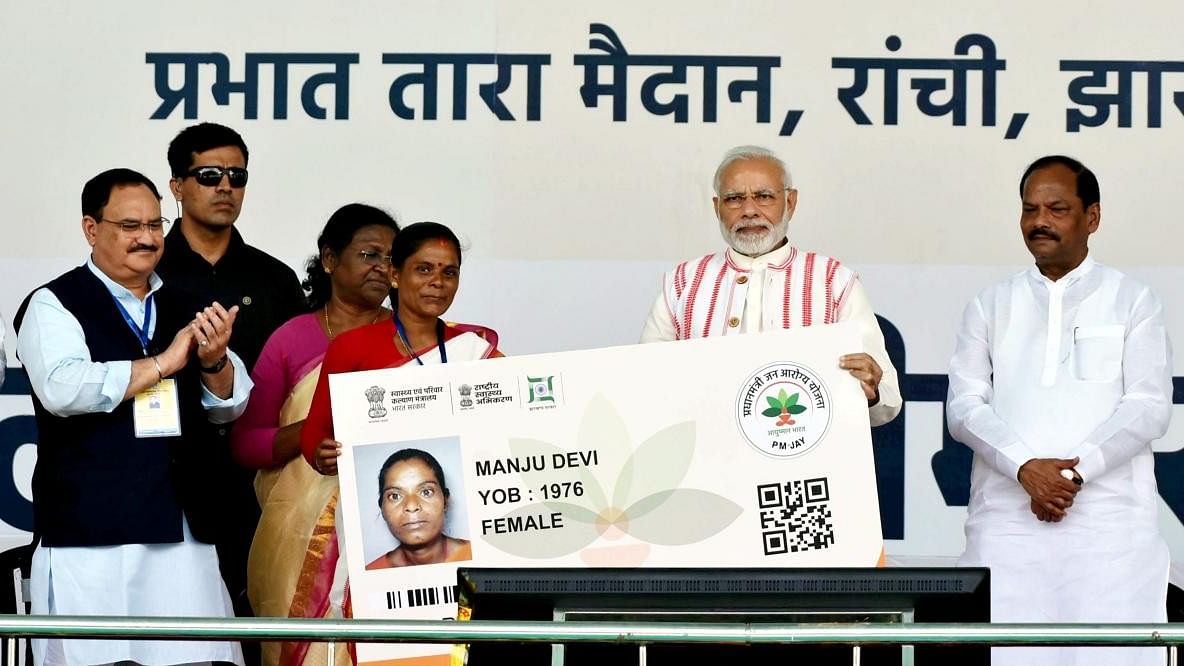
Prime Minister Narendra Modi presentS Health Insurance Card to a beneficary during the inauguration of “Pradhan Mantri Jan Aarogya Yojna”, in Ranchi.
Credit: PTI Photo
The Government of India, on October 3, approved ‘rationalisation’ of the centrally sponsored scheme (CSS) Rashtriya Krishi Vikas Yojana (RKVY), renaming it Prime Minister RKVY (PM RKVY) and extending it for another five years with a proposed outlay of Rs. 57,075 crore.
The RKVY was launched as the mega agricultural productivity improvement programme in 2007-2008 with a five-year Budget allocation of Rs 25,000 crore and a fundamentally different design transferring enormous authority to the states.
It has undergone many changes, mostly in form, funding, and role of states since 2014, primarily after the Narendra Modi government took over in 2014.
The government claimed that the states would have ‘an opportunity to prepare a Comprehensive Strategic Document on Agriculture Sector of the State in a holistic manner’, adopt a ‘cafeteria’ approach and state governments would have ‘flexibility to re-allocate funds from one component to another based on their state-specific requirements’.
Is there any real rationalisation in the latest edition of the RKVY? Will prefixing ‘PM’ to the RKVY make any difference?
Most innovative and flexible scheme
Agriculture is a state subject. Yet, by 2006, the Union government had started many schemes in agriculture and allied sectors to boost production and productivity, after the initial big push provided by green revolution technologies in the 1960s. The states, which implemented these schemes, often complained of their ‘one size fits all’ nature, and lack of flexibility.
The Manmohan Singh government came up with a game-changer. The RKVY, elaborately discussed in the National Development Council (NDC) in May 2007, was approved with features never adopted till then in India.
The RKVY (2007) provided large assistance to states as 100% grants, linked only to one condition of the states’ maintaining their base level investment in the sector. The states were also delegated complete authority to take up projects as per their choice and priority for boosting production and productivity in agriculture and allied sectors.
States were not required to send their RKVY plans for approval to the Union government. A state-level sanctioning committee (SLSC), headed by the chief sectary of the state, exercised this authority. A representative of the Department of Agriculture and Farmers Welfare (DoA&FW), the administrative department for the RKVY, participated as a member of the SLSC.
The Government of India only received state-approved RKVY projects and created an electronic database for national-level documentation, analysis, and cross-learning.
The RKVY functioned much in the same way until Modi came to power at the Centre in 2014.
Under one umbrella
In August 2016, the Modi government folded 66 CSSs into 30, and classified them into three categories: a) core of the core schemes (6), b) core schemes (22), and c) optional schemes (2).
The RKVY and all other CSSs operated by the DoA&FW were folded into a single ‘umbrella scheme’ — Green Revolution (Krishi Unnati Schemes and Rastriya Krishi Vikas Yojana).
The Centre also reduced the Union government grants for the RKVY from 100% to 60% for the general category states and 90% for special category states. The RKVY lost much of its unique character, authority to states, and flexibility.
Emergence (and disappearance) of RAFTAAR
In November 2017, the government approved the continuation of the RKVY with a fulsome name — Rashtriya Krishi Vikas Yojana-Remunerative Approaches for Agriculture and Allied sector Rejuvenation (RKVY-RAFTAAR), which essentially repackaged, not reformed, the RKVY’s existing interventions into new streams.
The RKVY-RAFTAAR fixed limits on state allocations for infrastructure and assets growth (35%), value addition linked production projects (21%), flexi-funds for projects of local needs (14%), special sub-schemes of national priorities (20%) and innovation and agri-entrepreneur development through creating end-to-end solutions, skill development and financial support for setting up the agri-enterprise (10%), including 2% for administrative costs.
RAFTAAR turned the RKVY into a straight-jacket and routine scheme. The SLSCs continued to exist, but for all practical purposes lost real authority. Somewhere on the way, the RAFTAAR suffix fell out of use.
In 2023-2024, the government did away with the distinction among the core of the core schemes, the core schemes, and optional schemes. It regained its plain nomenclature — the RKVY.
No real change in the latest edition
The latest edition brings no new focus, feature, flexibility, funding, or a cafeteria approach. The states also get no new authority to prepare strategic plans or use flexibilities. The RKVY remains a pale shadow of its 2007 avatar.
Depreciating office of PM
In December 2000, the prefix ‘Prime Minister’ was used by the Atal Bihari government for the first time to put the spotlight on the new and one of the most ambitious schemes — the Prime Minister Gram Sadak Yojana (PMGSY).
It was a powerful idea which designated a few big schemes of national importance and priority with a real transformative nature, to be monitored at the level of the prime minister. For the Modi government prefixing ‘PM’ to schemes was at first a fad, now it is a routine matter.
The addition of ‘Prime Minister’ to the RKVY has been done so routinely that hardly anybody noticed it. Now, prefixing ‘Prime Minister’ to Union government schemes makes little difference.
(Subhash Chandra Garg is former Finance & Economic Affairs Secretary, and author of ‘The Ten Trillion Dream’ and ‘We Also Make Policy’.)
Disclaimer: The views expressed above are the author's own. They do not necessarily reflect the views of DH.